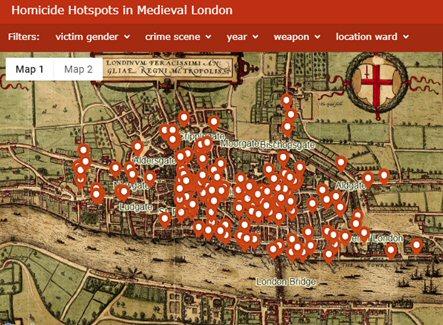
Submitted by Matt Skipper on Wed, 28/11/2018 - 09:09
University of Cambridge criminologist Professor Manuel Eisner has plotted all cases of murder from the surviving rolls – covering the years 1300 to 1340 – onto a digital map of the old city to show for the first time the ‘hot spots’ of lethal violence in medieval London. First digital map of 142 murders recorded by city coroner in early 1300s shows Cheapside and Cornhill were homicide ‘hot spots’, and Sundays held highest risk of violent death for medieval Londoners.
- First digital map of murders recorded by city coroner in early 1300s shows Cheapside and Cornhill were homicide ‘hot spots’, and Sundays held highest risk of violent death for medieval Londoners.
- New map of 142 detailed medieval murder cases released to the public today with a launch event at the University of Cambridge.
A selection of murders and a spreadsheet of all 142 cases available here: https://www.dropbox.com/sh/gemcqbk5kqm7bwq/AADjPui1RS506WZNEFbbQyCXa?dl=0
Stabbed by a lover with a fish-gutting knife. Shot with an arrow during a feud between rival students. Beaten to death for littering with eel skins. Shanked by a sore loser after a late-night backgammon session.
These were just some of the ways to die violently in the city of London during the 14th century, as catalogued in the ‘Coroners’ Rolls’: the records of the medieval official tasked with documenting sudden and unnatural death – whether accident, suicide or homicide.
Now, University of Cambridge criminologist Professor Manuel Eisner has plotted all cases of murder from the surviving rolls – covering the years 1300 to 1340 – onto a digital map of the old city to show for the first time the ‘hot spots’ of lethal violence in medieval London.
Building on work conducted by the historian Barbara Hannawalt over forty years ago, Eisner has also produced an analysis of the 142 homicides committed within the city’s boundaries during these forty years to reveal not just locations but the days, times and favoured methods.
Read more on The Guardian's website
